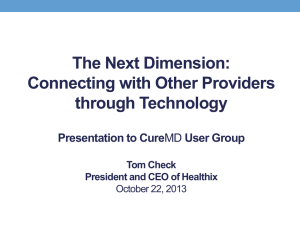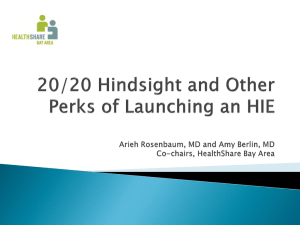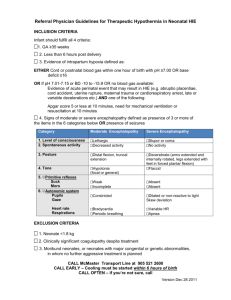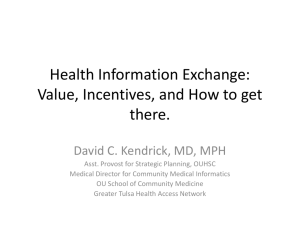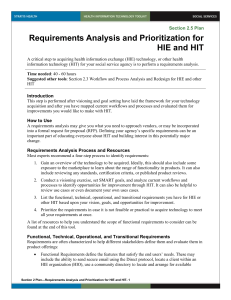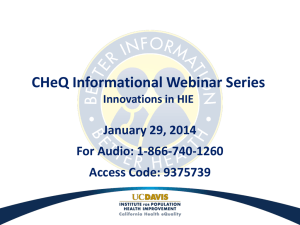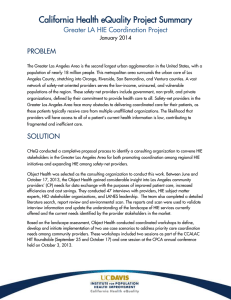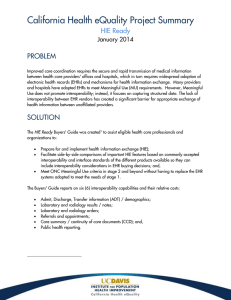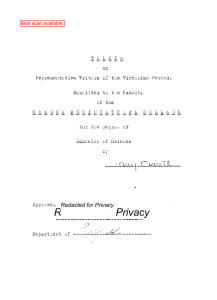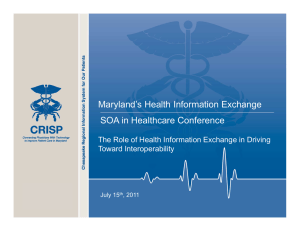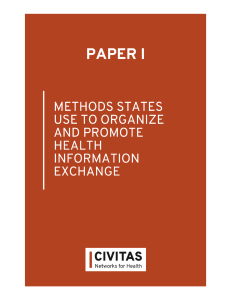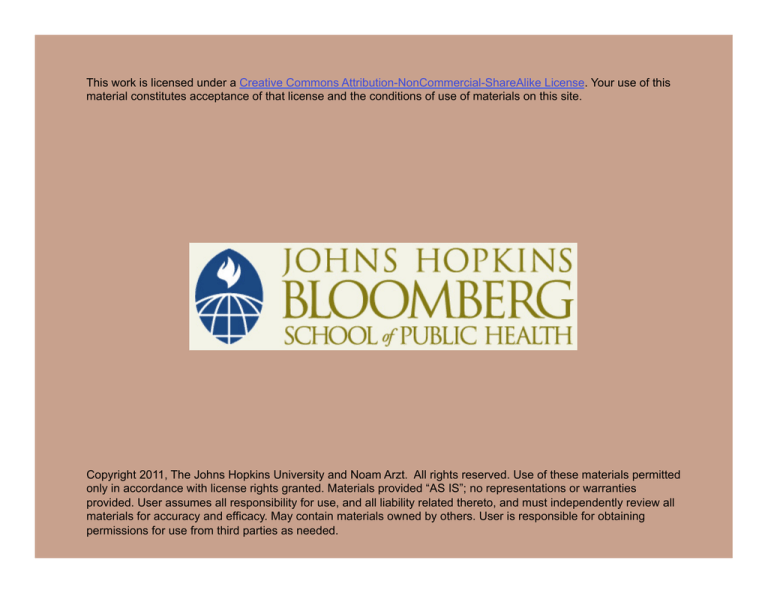
This work is licensed under a Creative Commons Attribution-NonCommercial-ShareAlike License. Your use of this
material constitutes acceptance of that license and the conditions of use of materials on this site.
Copyright 2011, The Johns Hopkins University and Noam Arzt. All rights reserved. Use of these materials permitted
only in accordance with license rights granted. Materials provided “AS IS”; no representations or warranties
provided. User assumes all responsibility for use, and all liability related thereto, and must independently review all
materials for accuracy and efficacy. May contain materials owned by others. User is responsible for obtaining
permissions for use from third parties as needed.
Section D
HIEs and HIOs
Why Is all this so Important?
The Health Information Exchange Network (HIEN) operated by The
Health Information Organization (HIO)
HIENs will be the context in which public health and provider
systems will interoperate
3
Evolution of Provider Systems
Clearinghouse
Health plans
Provider systems evolved
from focus on administration
to clinical support
Now systems have to be
certified
Many different solutions
available
Limited penetration
CMS incentives →
meaningful use
Billing system
Practice
management systems
EMR
EHR-S
Certified
EHR
4
What Is HIE?
Improved healthcare quality
Health Information
Technology (HIT)
Better control of cost
Improved health outcomes
Health
Information
Exchange (HIE)
Lower HIT investment risk
Improved efficiency
The action is at
the boundary!
Enhanced value of health information
More informed policy
HIT: infrastructure and data that help automate health care
processes
HIE: part of HIT that enables interoperability between systems and
organizations
5
What Is HIE?
Both a verb and a noun
Supported by Health Information Organizations (HIO)
May be driven by types of stakeholders, including clinicians,
hospitals, labs, pharmacies, patients, public health, payers
May be geographically-bound (city, region, state)
May be population-bound (underserved, veterans, IDN)
6
Health Information Exchange Network (HIEN)
HIENs come in different sizes and shapes, but usually share these
core components
Together, when interconnected, they will form Nationwide Health
Information Network
7
Health Information Organization (HIO)
A collaborative organization focused on health data exchange
Participants: physicians, labs, hospitals, pharmacies, patients,
public health, payers
Primarily driven by the private sector but often has public health
involvement (and may be driven by the public sector)
Usually focused on clinical data exchange but may focus on health
services data in addition or instead
Can span a metropolitan area, region, or a state
8
Brief History of HIE in the US: Before HITECH
Initial slow pace of HIT and HIE
growth
- Targeting health care
efficiencies
- Organized to support
defined business
relationships/interests
- Financed largely by
providers (some limited
grants/contracts)
-
Some “proto-HIEs” in
public health
(immunization registries)
State-level HIE initiatives
coalesce
Focus on requirements for
realizing broad HIE benefits
Some early efforts thrived,
some failed
Enablers of success
- Shared vision
- Incremental approach
-
-
-
The Internet: ubiquitous
and pervasive
In some cases, tightly
coupled to health care
delivery
Strong commitment to
medical informatics
9
HIEs: Early Examples
Success: Indiana Network for Patient Care
- Strong informatics perspective: Regenstrief
- Use of standards
- Incremental approach
- Embedded in care delivery processes
Failure: Santa Barbara County Care Exchange
- Over-reliance on grant funding
- Lack of sustained local community leadership
-
-
Technology limitations
Lack of compelling value proposition
10
HIE “Golden Rule”
Health Information Exchange must deliver clear value to its
participants
11
HIEs Today
Driven from many directions
Spurred on by various ARRA/HITECH funding programs
- CMS Incentive Program for Electronic Health Records
- State Health Information Exchange Cooperative Agreement
Program
- Beacon Community Program
Encouraged by health care reform in many states
Cautiously flourishing in many parts of the country
12
Enablers and Barriers of HIE Development
Enablers of HIE
- Interest and momentum—is
it enough?
- Standards—march
continues on
- Public health expertise—
leverage possible
- The Internet—pervasive
and ubiquitous
Barriers to HIE
- Financial—need strong
business case
- Standards—not fully
developed
- Identification—no national
patient identifier
- Authentication—of
participants
- Organizational—publicprivate boundaries
- Vocabulary and
terminology—language
- Technology—limited, but
improving, interoperability
13
Public Health and HIEs
Contributions by public health
- “Quick start” by leveraging existing activities, including
interfaces to labs and providers
- Existing data, including consolidated data and population-based
data
- Expertise: de-duplication, database management, web
applications, data exchange including HL7
- Existing relationships with many relevant stakeholders:
- Hospitals, providers, payers, professional associations
- Governance: experience in negotiating and implementing data
sharing agreements
14
Public Health and HIEs
Benefits to public health
- Better to be an insider than an outsider: public health risks
being left out as the medical community moves ahead
- Meaningful use: facilitate achievement
- Can help achieve key public health goals
- Many of public health’s data trading partners will choose to
interoperate with an HIEN and reduce (or eliminate!)
superfluous connections
- Public health can gain access to data and trading partners who
previously might not have participated in its initiatives
15
Meaningful Use and Public Health
Policy priority: “Improve population and public health”
Three Stage 1 objectives:
- Submit data to Immunization Registries (Eligible Providers,
Hospitals)
- Submit reportable lab results (Hospitals only)
- Submit syndromic surveillance data (Eligible Providers,
Hospitals)
Proviso: unless PH does not have the capacity to receive the data
16
Meaningful Use and Public Health
Stage 1 requirements relatively light, with a big “escape clause”
Stage 2 requirements likely to be more stringent
NIST has established a guidance document and testing tools
Many public health agencies under-funded to enable data exchange
capacity in their systems or to refocus data exchange to an HIE,
though CDC Interoperability Grants will help
17
Risks to Public Health
Public health applications targeted at these users may have slower
uptake as organizations encourage (or require) users to stay with
institutionally-supported applications
Pressure will build for providers to interoperate solely through HIENs
Public health systems run the risk of becoming focused as data
repositories as users over time lose access to their distinctive
features
While many specialized features are part of the approved HL7 EHR
specification they are not yet required for certification
18


